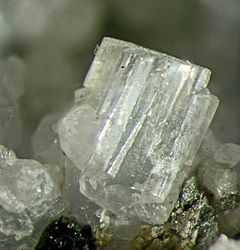Dawsonite
From Wikipedia, the free encyclopedia
| Dawsonite | |
|---|---|
 Dawsonite from Mont Saint-Hilaire, Rouville RCM, Montérégie, Québec, Canada | |
| General | |
| Category | Carbonate minerals |
| Formula (repeating unit) | NaAlCO3(OH)2 |
| Strunz classification | 05.BB.10 |
| Dana classification | 16a.03.08.01 |
| Crystal symmetry | 2/m 2/m 2/m |
| Identification | |
| Formula mass | 144.00 |
| Color | white |
| Crystal habit | encrustations or radial |
| Crystal system | orthorhombic |
| Cleavage | perfect on {110} |
| Fracture | uneven |
| Mohs scale hardness | 3 |
| Luster | vitreous |
| Streak | white |
| Diaphaneity | transparent |
| Specific gravity | 2.436 |
| Refractive index |
nα = 1.466 nβ = 1.542 nγ = 1.596 |
| Birefringence | δ = 0.130 |
| 2V angle | 77° |
| References | [1][2] |
Dawsonite is a mineral composed of sodium aluminium carbonate hydroxide, chemical formula NaAlCO3(OH)2. It crystallizes in the orthorhombic crystal system. It is not mined for ore. It was discovered in 1874 during the construction of the Redpath Museum in a feldspathic dike on the campus of McGill University on the Island of Montreal, Canada.[1] It is named after geologist Sir John William Dawson (1820–1899).[2]
The type material is preserved in the collection of the Redpath Museum.[1]
See also
- List of minerals
- List of minerals named after people
- Dihydroxialumini sodium carbonate, the commercial (artificial) form, used as an antacid
References
This article is issued from Wikipedia. The text is available under the Creative Commons Attribution/Share Alike; additional terms may apply for the media files.